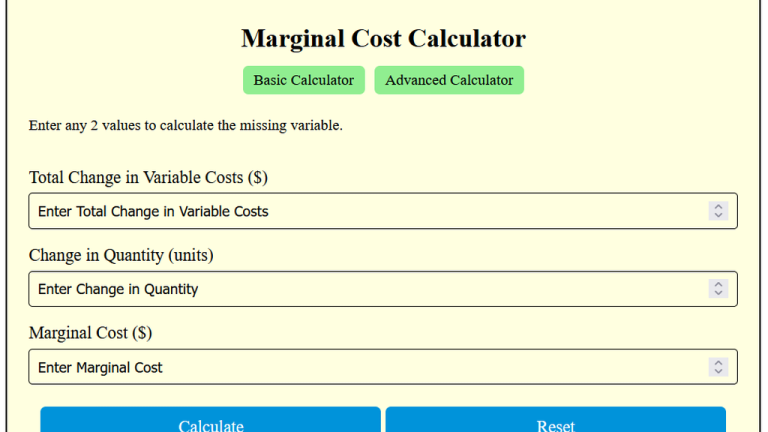Formal Charge Calculator
To determine Formal Charge (FC), subtract the number of non-bonding electrons and half the bonding electrons from the atom’s valence electrons. This helps in assessing molecular stability by calculating charge distribution.
To determine Formal Charge (FC), subtract the number of non-bonding electrons and half the bonding electrons from the atom’s valence electrons. This helps in assessing molecular stability by calculating charge distribution.
The Formal Charge Calculator aids in calculating the formal charge of atoms in molecules. It is a vital tool for predicting molecular geometry and stability.
To put it simply, formal charge reveals whether an atom in a molecule has more or fewer electrons than in its neutral state, often used in chemistry to analyze compounds like CO₂, NH₃, and SO₂.
It is noteworthy that this calculator is particularly helpful for students, researchers, and chemists, providing a quick method to determine molecular charge distribution and improve understanding of molecular structures.
| Variable | Description |
|---|---|
| FC | Formal Charge on the atom |
| V | Valence electrons of the atom |
| LP | Lone pair electrons (non-bonding electrons) |
| BE | Bonding electrons (shared in bonds) |
Example 1: Calculate the formal charge of oxygen in CO₂ (O has 6 valence electrons, 4 bonding electrons, and 4 lone pair electrons).
| Step | Calculation |
|---|---|
| 1 | FC = 6 – (4 + 0.5 * 4) |
| 2 | FC = 6 – (4 + 2) |
| 3 | FC = 0 |
| Answer | 0 |
Example 2: Calculate the formal charge of nitrogen in NH₃ (N has 5 valence electrons, 6 bonding electrons, and 2 lone pair electrons).
| Step | Calculation |
|---|---|
| 1 | FC = 5 – (2 + 0.5 * 6) |
| 2 | FC = 5 – (2 + 3) |
| 3 | FC = 0 |
| Answer | 0 |
A Formal Charge Calculator is a charge-oriented tool. In chemistry, it is primarily used to figure out the formal charge of atoms within molecules. Formal charge helps indicate if an atom is gaining or losing electron density. This process can reveal the stability of molecular structures.
For instance, it’s essential to calculate the formal charge of common atoms, like hydrogen or oxygen, within compounds to understand molecular behavior.
The formal charge of an atom is calculated using a specific formula: Formal Charge = Valence Electrons – (Nonbonding Electrons + Bonding Electrons/2). Calculating this facilitates chemists in understanding molecular reactivity and polarity.
Thus, using a calculator simplifies this process, especially for complex molecules, by automatically assessing values from the periodic table and applying them to the formula.
To conclude here, a Formal Charge Calculator is a valuable tool for quickly analyzing molecular structures, making it easier to determine electron distribution and predict chemical reactions accurately.
To calculate the output voltage of a capacitor, multiply the initial voltage by the exponential of the negative ratio of time to the product of resistance and capacitance. The Capacitor Output Voltage Calculator aids in finding the voltage across a capacitor over time. In an RC circuit, a capacitor charges and discharges exponentially depending on…
Enter the values to use our basic and advanced A/g Ratio Calculator today! The albumin-to-globulin (A/G) ratio is a key indicator of liver function and overall health. The calculation helps you to figure out the balance between albumin and globulin in your blood, with a normal range typically between 1.0 and 2.1. Formula: The formula…
Snow day chances are determined by analyzing weather conditions, snowfall predictions, temperatures, and other meteorological factors. The Snow Day Chance Calculator predicts the likelihood of schools or workplaces being closed due to heavy snowfall. It considers factors like forecasted snow accumulation, wind speeds, and temperature thresholds to estimate closures. This tool is popular among students,…

To determine marginal cost, divide the change in total variable cost by the change in quantity produced. This measure is essential for understanding the cost of producing additional units. The Marginal Cost Calculator enables you to precisely calculate the additional cost incurred by producing one more unit of a product. It’s best suited in economics…
To calculate CAPM Beta, divide the difference between the expected return of the investment (ERiER_i) and the risk-free rate (rfr_f) by the difference between the expected market return (ERmER_m) and the risk-free rate. The CAPM Beta Calculator is a helpful tool for assessing the systematic risk of an investment compared to the overall market. Beta…

To calculate the area of a hole, square the radius (r) and multiply the result by pi (π). This will give you the area of the hole in square units. A Hole Area Calculator is used to compute the area of a circular hole, which can be useful for various applications like calculating the size…